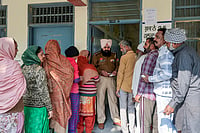The exit polls for the recently-concluded state and municipal elections began to be released on Monday evening.
A day after Delhi voted in Municipal Corporation of Delhi polls (MCD elections), various pollsters released their exit polls, broadly predicting Aam Aadmi Party (AAP) to win MCD, the Bharatiya Janata Party (BJP) to win Himachal, and a potential tough fight in Himachal Pradesh where BJP is in the lead.
While Delhi voted on Sunday, Gujarat voted in two phases on December on Thursday and Monday and Himachal Pradesh voted on November 12.
While the contest was bipolar in Himachal, AAP emerged as a major challenger in Delhi and Gujarat. In Gujarat, it turned the traditional bipolar contest into a triangular contest. Though exit polls predict that the Congress will still be the second-largest party in Gujarat and AAP will come third.
So far, the experiences of exit polls suggest that they often present a broader picture of the election results but remain far away from the results after counting. There have been instances in the past when exit polls have failed to capture the precise mood of voters.
Accuracy of exit polls
The accuracy of exit polls has been a long debate since time immemorial. The polls aim at predicting the most accurate results after questioning voters and sampling interviews.
Exit poll began in India in 1957 and since then, there have been times, when certain exit polls had predicted it right, while others did not. It is said that exit polls can never be accurate, they can only paint a bigger picture of a constituency and its political ambience.
Back in 1966, the exit poll conducted by Lokniti-CSDS for the Lok Sabha elections had correctly predicted a hung assembly. The actual results saw the BJP a few seats ahead — just enough to form the government.
In 2017, when Uttar Pradesh, Goa, Manipur, Uttarakhand and Punjab had gone for Assembly elections, exit polls predictions came mixed and mostly wrong.
In UP, most exit polls had predicted that there would be a hung assembly but BJP would still emerge as the largest party. Most exit polls had predicted that BJP’s win would be around 160 to 180 seats, whereas 202 seats are required in a 403-seat Assembly for any party or coalition to come out as a majority.
However, India Today-Axis survey and Today's Chanakya had predicted a win around 251 to 279 and 285 seats. Close to that, BJP came out winning 312 seats and its allies, the Apna Dal (Sonelal) and Suheldev Bharatiya Samaj Party won nine and four seats respectively, taking the BJP+'s count to 325.
Similarly, in Uttarakhand, Chanakya-News24 was closest to predicting BJP’s win. It had predicted that the saffron party would grab 53 seats and Congress 15. In reality, BJP won 57 seats and Congress 11.
The situation in Punjab looked different. While most exit polls had predicted that there would be a surge in AAP’s numbers in the state with approximately 40 seats, AAP had won only 20 seats.
The exit poll prediction of the 2014 general elections was a mixture of correctness and failure. Most exit polls had predicted that the BJP-led NDA was close to forming the government but the BJP coalition would be just short of the majority mark of 272. When the results came, the BJP alone crossed the majority mark on its own, and the NDA won 336 seats. The Congress was reduced to 44 seats.
However, the situation was somewhat opposite in the 2015 Bihar Assembly elections when the majority of the exit polls had predicted that BJP would edge over the JDU-RJD alliance. In reality, BJP was reduced to 58 seats, while the alliance won 178 seats.


























